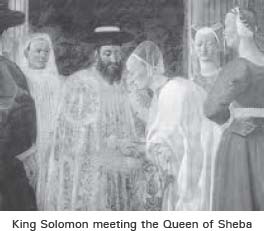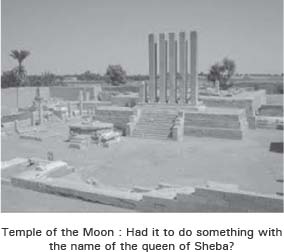
For many centuries, the queen of Sheba has baffled people. According to the Bible, Queen of Sheba visited King Solomon with rare gifts. But the question is how far can one believe the Bible? Did she really exist? And if she existed, then where was the land Sheba? Was she a queen, a noble woman, a witch or simply a seductress? Did she marry Solomon? Was Haile Selassie, the last emperor of Ethiopia, the direct descendant of a union between the Queen and the King Solomon?
Innumerable questions surround the personality of the Queen of Sheba. And the incident is open to controversy and research till now.
The name – Queen of Sheba, first appeared in the Bible in the tenth chapter of the First Book of Kings. Her story is narrated in the following way: “And when the Queen of Sheba heard of the fame of Solomon concerning the name of the Lord, she came to probe him with hard questions. And she came to Jerusalem with a very great train, with camels that bare spices, and very much gold, and precious stones.”
“King Solomon answered Queen of Sheba till she was satisfed. At last she was pleased with his answers and presented him with her gifts of gold, species and precious stones. After that she returned to her own country with her servants.”
The same story stated above is repeated in the ninth chapter of the second Book of Chronicles, although with some changes despite the extensive accounts of Queen of Sheba. Both the Books in the Bible do not mention anything about Sheba’s country, her race, her name or about her appearance. While in the Gospel of St. Mathew, Jesus or about her appearance. While in the Gospel of St. Mathew, Jesus speaks of the queen of the south who, “came from far away part of the earth to test the wisdom of Solomon.” Thus, the Bible ceases to inform further about Sheba. And because her name has been mentioned in the Bible, people took it for granted that a character existed by the name of Queen of Sheba. But the pertinent questions could not be answered. For distance, who was she and from where did she come? Because such questions were not answered in the Bible, the name Queen of Sheba has remained mysterious for many centuries.
The question arises whether Bible can be taken as a base for historical truth? The first half of the First Book of Kings is the story of forty years of kings. And in this, the story of King Solomon is written. It is assumed that the story of King Solomon must have been written shortly after his death. So, there must be some historical truth in the text.
According to the Bible, Queen Sheba Visited Solomon when he was at the peak of his power. His garrison controlled all roads from the Euphrates to the Sinai Desert and from the Red sea to Palmyra. The visit of Queen of Sheba is mentioned carefully. When she arrived, Solomon had completed the great temple and the royal city of Jerusalem. Queen of Sheba saw his wisdom and power and was greatly impressed. She gave the King a hundred and twenty talents of gold and great store of spices and precious stones. As she gave these things to the King, historians often guess that she must have visited the place for commercial agreements. And it is here that the Book of Kings fails authenticity. It says nothing about the practical objective of her visit. It says that she merely exchanged gifts and departed.

As far as facts about King Solomon matters, the Bible gives enough evidence. According to the Bible, Solomon was the son of King David. He killed his eldest half-brother Adonijah. Soloman retained peace in his kingdom by raising a great army of 12,000 horsemen and 1,400 war chariots. He consolidated his rule over the tribes of his kingdom. He formed alliances with his neighbours and for cementing there alliances, he married. He also married the daughter of the Pharaoh of Egypt.
Solomon took the help of the Phoenicians and traded extensively. He sent 10,000 men a month to work in the mountains of Lebanon. At home, he had 70,000 hauliers and 80,000 quarrymen, working on his great temple. Solomon accumulated so much gold that he used it to cover the walls of the great temple to the glory of Jehovah. He himself sat on the throne of ivory laid with gold. He also ate in gold utensils
Queen of Sheba also heard of such wealth. She was intrigued by the wealth and splendour of King Solomon, and hence, she paid a visit to the King. The Bible, no doubt, has little to say about her but the tradition and folklore have much information to impart. The religious arts of the Christian Middle ages and Renaissance often portray her. The sculptures of the Gothic Cathedrals of France England, Germany and Italy often show her as a queen and at times as a sorceress.
In the 19th century, she played another role. In Gustave Flaubert’s ‘Temptation of Saint Anthony’ (began in 1846 and completed in 1874), the queen is made to represent Iust. She attempts to woo the hermit Anthony in the desert near Thebes. First she tempts him with her wealth and when she fails in her attempts, she tempts him with her body. When Anthony is not tempted by her physical charms also, she reveals a deformed foot and goes away.
While in the Koran, the queen is called to the court of King Solomon after an exchange of letters between them. In the Jewish Book of Esther, she is supposed to have met the king in a room with a glass foor. She has hairy feet in the story. This hairy feet, in the later stories transforms into a hairy body—a mark of the demon. In addition to all these stories, some of the Jewish stories also identify the queen with Lilith, a demonic seductress. This concept is, perhaps, borrowed from Assyrian and Babylonian myths.
According to the Islamic myth, Solomon married Sheba. He first converted her into Muslim and them married her. She is called Bilkis in Islamic tradition. The Temple of the Moon in Yemen is often called the Haram Bilkis, meaning the palace of Bilkis, the Queen. The inference here is obviously to the Queen of Sheba.
The view about the Queen of Sheba had hardly undergone a change in the 20th century. She remains seductive. W.B. Yeats often portrayed her sexual and them secular nature. Her name is mentioned in Rudyard Kiplings’ stories and in John Dos Passos’ novel, ‘Three Soldier’. In 1934, French journalist, Andre Malraux claimed to have discovered her white city while fying over the desert of Southern Arabia. What he saw, nobody could comprehend.
Some ancient writings point the Arabian Kingdom bordering the Red Sea as her Kingdom. Legends and myths surround her name. In fact, the birth of her name can be traced to Genesis where it was not a place but a person, a descendant of Noah’s son, Shem, the father of the Semites. Sheba had twelve brothers. The names of the brothers were adopted by people and places in Arabia. Till 6th century A.D., Hazarmoth, Sheba, Ma’ in and Qataban were combined together. Out of these four, the place Sheba was the biggest. Frankincense and myrrh tree were grown on the mountain slopes of the country. Trade formed the basis of these trees. A Greek historian, Diodorus Siculus (1st century B.C.) described the riches of the capital city.
The natives of Sheba worshiped the Sun, the Moon and Venus. Their government led by priest kings was similar to the sumerian system. And their writings and alphabet were similar to those of the Phoenicians.

Sheba was protected from all sides by desert. In 25-24 B.C., Roma army under Aelius Gallus invaded Sheba but many soldiers died from heat and thirst. It was only four centuries later that the region could be attacked again.
The name of Sheba appears in Classical writings too. Herodotus, Strabo, Pliny-the Elder and Diodorus Siculus, all mention Sheba.
There are lots of tales about the Queen Sheba. But hardly any fact emerge about Sheba, the land. Many of the stories which surround her are far away from rationality thus, her mystery still attracts people to probe further and around the true story.
